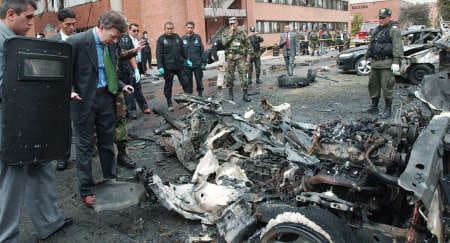Colombia is a country whose experience can offer valuable lessons to Afghanistan. Here, the Colombian Minister of Defence outlines how strategies to regain territorial control and tackle drug production and consumption have helped his country.

Colombian Defence Minister Juan Manuel Santos briefs Colombian President Alvaro Uribe (© AP / Reporters )
At first glance, Colombia and Afghanistan appear to have little in common.
Colombia is almost twice the size of Afghanistan. Its population, at over 42 million, is almost 50% higher than Afghanistan's. Three times as many people live in cities in Colombia than in Afghanistan. And whereas Afghanistan is characterized by rugged and mountainous terrain, Colombia has many areas covered by jungle.
But it is the difficulty in accessing large parts of territory - and the use that terrorist and drug trafficking groups have made of them - where the similarities between the two countries begin.
In Colombia, these groups have intimidated the local populations of these remote areas for decades, where state presence and authority have been historically weak. In Afghanistan, the Taliban continues to attempt to use much of the south of the country as both a fighting base and a source of revenue from the opium trade.
The main challenge taken on by Colombian President Alvaro Uribe's government since 2002 has been to recover control of this type of region in his country and establish a permanent state presence.
This has required enormous military effort, which has already made a major difference.
For example:
In 2002, 158 Colombian municipalities had no government security forces. Today, these forces are permanently stationed in all 1,099 Colombian municipalities allowing the elected civilian authorities to operate without difficulty.
Every operation carried out by the armed forces and the police must be designed and executed in line with the 'Integrated Action doctrine'
Between 2002-2006 national crime rates declined significantly across the board with kidnapping for extortion dropping from 1,709 cases to 282, assaults on towns by illegal armed groups down from 32 in 2002 to 4 in 2006, and terrorist attacks reduced from 1,645 in 2002 to 646 in 2006.
And while in 2002 pressure and violent threats kept 131 mayors from exercising office from their municipalities, in 2006 that figure was reduced to four mayors.
Consolidating democratic security
The next step for the Uribe Government is implementing the Consolidation of Democratic Security Policy.
The main objective from 2006 to 2010 is to move from securing territorial control to consolidating social control. In other words, the Colombian military and police need to guarantee the free functioning of all democratic institutions.
Government security forces will work together with regional authorities and various federal agencies to fulfill two goals in each region freed from violence:
- stronger democracy for greater governability;
- and social recovery to permit economic productivity.
One example of how consolidating territorial control has made a real difference to people's lives is the new town of Gúnmaku. In 2004, a military strategy set out to dismantle terrorist and drug trafficking structures in the Sierra Nevada Mountains of Santa Marta, in northern Colombia. By reviewing military positions, the Colombian forces were able to cut off the terrorists' supply lines and engage them in their own camps.
The effects were considerable: between 2004 and 2006, the homicide rate fell by 50%, kidnapping decreased by 91%, and activities by illegal armed groups dropped by 64%.
During the time of the Uribe Government's operations in Colombia, army and police actions were coordinated by the Center for the Coordination of Integrated Action (CCAI) - a presidential agency which coordinates all government efforts focused on social consolidation. It took charge of coordinating various social development and reconstruction programmes for settlers and indigenous peoples in the region.

Minister Santos inspects the remains of car bomb which exploded at a military school in Bogota, Colombia. Sixteen people were injured (© AP / Reporters )
The result of this combined military, police and social effort, was the inauguration in April 2007 of the new town of Gúnmaku. It became home to more than 1,000 Arhuaco Indians and 950 Kogui Indians, and guarantees the security of an important part of the Sierra Mountain population and ecosystem.
The Integrated Action Doctrine
The concept behind the social and institutional recovery of areas is civilian-military inter-agency coordination. The implementation of this is based on the "Integrated Action Doctrine," which applies to all military operations in the consolidation phase.
This doctrine provides members of the government security forces with all the necessary principles and protocols to properly coordinate with other state institutions.
This means that every operation carried out by the armed forces and the police must be designed and executed in line with this doctrine..
The basic principles of the Integrated Action Doctrine are:
- Protecting the population and satisfying its basic needs.
- Unity of effort and inter-agency coordination, particularly between military units and civilian agencies, is key to the consolidation of territorial control.
- All military and social actions are completely interdependent. The failure of one will thwart the success of the other.
- The role of military effort is to protect the population and their resources, to identify their needs, and to guarantee sufficient security to allow the social action institutions to work with the people.
- Social action is crucial to create stable conditions for the consolidation of territorial control.
- When necessary, the armed forces and the police will carry out civilian and social tasks to provide for minimum basic needs of the population.
- Local is strategic. Local efforts and results have a strategic effect.
- This is a medium and long-term effort. There are no easy answers or perfect solutions.
Again, NATO has a similar stance on integrating efforts, in its proposed 'Comprehensive approach'. This would ensure that efforts are coordinated within and between agencies, institutions and governments. It would also provide a coordinated top down structure, rather than an ad hoc response to situations on the ground. And it would link the before, during and after of operations, ensuring that preparations, tactics and post conflict efforts are all linked.
Lessons learned
In Colombia, although the process for the consolidation of territorial control is still in its initial phase, we have been able to identify some important lessons. These are not only useful to us in improving our own efforts, but may contribute to other similar efforts in places like Afghanistan.
Friction. The military historian Clausewitz spoke of 'friction in war' to explain the enormous difference between planning war on paper and executing war on the ground. Colombia has also experienced 'friction' in inter-agency coordination, both between civilian and military agencies and between different civilian agencies. In practice, coordination is a continuous process of negotiation between agencies, each one attempting to retain the greatest degree of independence.
Never abandon a region. Once troops reach a zone, they must remain for the duration of the consolidation process
Opportunity dilemma. Finding the right balance between military and social effort remains difficult. Our experience has shown that without minimum security conditions, social efforts are fruitless. For that reason, the first advance is military.
Military criteria must continue to be the genesis of the consolidation. Selecting regions for consolidation must be based on a military strategy that will destabilize enemy plans and positions. So the military must establish the first strategy for consolidation which can be supported later by social activities.
Never abandon a region. Once troops reach a zone, they must remain for the duration of the consolidation process. Otherwise criminal groups will return to take reprisals against the population and generate greater mistrust of the state.
Align efforts with international cooperation. In Colombia, different international cooperation agencies support the consolidation effort. In practice, these agencies don't always act with the same interests. So it is essential to coordinate and align the activities of local (state) agencies with international cooperation agencies. And it is clearly highly important to maintain international political and economic support for the consolidation process.
Break the cycle of mistrust. In regions where terrorist groups have traditionally exercised influence, the arrival of state organizations is often greeted with profound mistrust by the people. This hostile reception in turn generates mistrust on the part of the state, meaning the initial phase of consolidation takes place in a climate of suspicion. The primary task of the consolidation effort is to break this cycle of mistrust - largely by embarking on a series of confidence-building measures.
But the most important and underlying lesson learned in the Colombian case is that security cannot be an end in itself. Security must always be a means for maintaining the governability of the state, producing well-being and fostering social progress. Colombian armed forces can only gain the upper hand against terrorism if we create the necessary conditions to guarantee an effective state presence and social development in our communities.
Those involved in consolidating territorial control in complex threat environments like Colombia or Afghanistan should share experiences and expertise on a regular basis, otherwise ungoverned spaces will continue to breed terrorism and crime.
